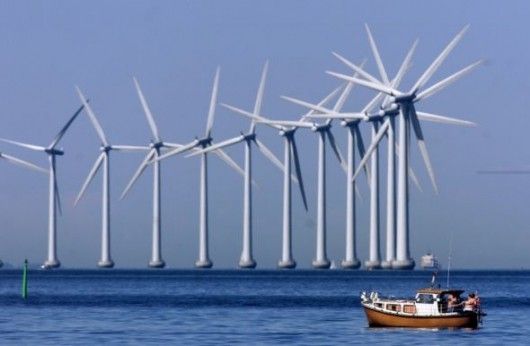Flourishing European Offshore Wind Energy Sector at Record High in 2020

Offshore wind is a promising renewable energy source that is predicted to contribute to the global and European to improve their decarbonization efforts the domestic economy by 2050 and keep global warming to around 1.5°C above pre-industrial levels standardized in the Paris Climate Change Agreement. The European Commission is estimated that the EU is prepared to produce a minimum of 240 GW (gigawatts) of global offshore wind power capacity before the end of 2050. International energy associations and organizations are even more optimistic about this energy source prospect. Europe accounted for around 80% of global offshore wind capacity and is the dominant region in manufacturing and technologies. At the same time, Europe offshore wind accounts for 210,000 jobs (over half of all wind energy jobs). This number would increase further with more significant investment from the government and local sources.
Europe remains the global leader in offshore wind, with 80% of total capacity and significant new investments planned by the several Member States. Within the EU-28, offshore wind accounts for 10% of total wind energy capacity and 23% of annual capacity additions in 2018. According to figures from the European Investment Bank, 10 million households in the EU-28 are now served by offshore wind energy. Nevertheless, offshore wind in Europe is currently concentrated in a handful of countries with territorial waters in the North Sea: the UK (44% share of capacity), Germany (34%), Denmark (7%), Belgium (6.4%), and the Netherlands (6%). In the UK and Belgium, offshore wind accounts for over a third of total wind power.
Europe is unlikely to lose its leading role in the offshore wind sector in the coming years. Under the International Energy Agency (IEA) introduced policies scenario (based on existing government policies), the EU and UK combined will account for nearly 40% of the global offshore market by 2040. Growth in overall installed capacity in the market will be almost 130 GW. Moreover, the offshore wind would then deliver 16% of the region's electricity supply by 2040 (compared to 12% by 2030)
Figure - Offshore wind installed capacity and share of electricity supply by country, 2018
Source: IEA, Offshore Wind Outlook - Special Report, International Energy Agency, November 2019.
The reason offshore wind has such potential for job creation in Europe is that EU companies have a dominant technological and manufacturing position in the European market. As more countries worldwide seek to develop offshore wind, this provides promising new export avenues for the European industry. According to a Joint Research Centre technology market report, three EU companies account for 98% of the market share for wind turbines in Europe: Siemens-Gamesa (69%), MHI Vestas (24%), and Envion (5%). 4 European manufacturers also dominate the global market for foundations, electricity substations, offshore cables, and installation vessels. Yet continued European dominance in this sector is not a given.
Global Wind Energy Council (GWEC): The wind power industry intended to install 71.3 GW in 2020, display resilience during the COVID-19 pandemic
Wind power is expected to continue to witness record growth in the coming five years despite the COVID-19 impacts and further make a crucial contribution to domestic economic recovery.
- According to the GWEC Market Intelligence report, almost 71.3 GW of wind power capacity is projected to be installed in 2020 despite the COVID-19 impacts, which shows a decline of 6% from pre-COVID forecasts Q1 2020.
- The wind industry is on track to achieve record growth in the upcoming next five years, with around 348 GW projected to be installed between 2020-2024, bringing total global wind power capacity to approximately 1,000 GW by 2024, which is almost 54% in growth rate for total wind power installations compared to 2019.
- The wind industry's continued growth despite COVID-19, even while other industries such as oil & coal have seen wide price fluctuation and considerable demand drop, demonstrates its role in building sustainable and reliable economies.
2020: An Opportunistic Year for European Offshore Wind Investments
But despite positive trends in offshore wind technology and finance last year, more still needs to be done to deliver the volumes European governments want, industry body WindEurope warned. Moreover, A record Euro 26.3 billion was invested in new European offshore wind farms in 2020, but new installations continued to lag behind the volumes needed to hit EU targets.
These investments will finance 7.1 GW of new capacity, but this still falls well short of the annual installations needed to meet European governments' targets. Meanwhile, new grid-connected capacity dropped from record levels in 2019, though the 2.9 GW brought online last year was in line with WindEurope's pre-coronavirus pandemic forecast.
The industry body also noted increased interest from corporate off-takers, turbines' increased power ratings, and greater interest in areas beyond the North Sea. However, it warned that installations need to ramp up. There is still a need for new development to enable cross-border offshore wind farms, simplify and accelerate project permitting and improve maritime spatial planning.
Investment in Europe
The record Euro 26.3 billion investments in seven new projects off the UK, the Netherlands, Germany, and France will finance 7.1 GW of offshore wind capacity. This Euro 3.7 million/MW investment average is below previous levels. In 2019, final investment decisions (FIDs) were made on four wind farms, with an average investment of Euro 4.3 million/MW – although this included France's first offshore wind farm, the price of which had been pushed up permitting challenges and having to manufacture the project's turbines in France, following tender rules.
The UK has attracted Euro 59 billion of new investments since 2010, making it Europe's largest offshore wind market for capital spending commitments in the past ten years, ahead of Germany, where Euro 28 billion has been spent in the same period.
Installations in Europe
Nine new offshore wind farms were connected to the grid in five countries last year, with the most capacity installed off the Netherlands (1,943 MW), followed by Belgium (706 MW), the UK (483 MW), Germany (219 MW), and Portugal (17 MW).
The 2.9 GW connected to the grid last year was in line with WindEurope's expectations and was down from a record 3.6 GW added in 2019.
Annual offshore wind installations by country (left axis) and cumulative capacity (right axis) (GW)
Europe now has 25 GW of operational offshore wind capacity.
Hope and Scope for Bigger and Better Future
The average size of offshore wind turbines in European waters continued to grow from 7.8 MW in 2019 to 8.2 MW in 2020.
*Yearly average of newly installed offshore wind turbine rated capacity (MW)
There were large orders placed for GE's 13 MW model in 2020, while both the US tech giant and rival manufacturer Siemens Gamesa also announced new 14MW turbines. New offshore wind farms now have capacity factors of more than 50%, according to WindEurope.
The Task Ahead: A Conclusion
Despite optimistic trends in finance and technology, more still needs to be done to deliver the volumes needed to reach European governments' collective commitments of 111 GW offshore wind capacity by 2030 and the EU targets of 300 GW by 2050.
In 2019, the EU published its offshore renewable energy strategy, which introduces its targets to 300 GW offshore wind capacity, especially in the EU-27 by 2050. Including non-member states' drives, primarily the UK and Norway, it is expected that Europe could have around 400 GW of offshore wind capacity by mid-century if all strategic plans are achieved. Furthermore, WindEurope specified there is no reason to assume these targets could not be hit but cautioned that the next 2-3 years would be crucial for setting the right framework to meet these targets.
The industry body added that the European governments would need to tamp up from the current 3 GW/year level to 11 GW/year by 2026 and further maintain the region's installation pace. The European has a comprehensive legislative framework for hybrid offshore wind projects, enhanced maritime spatial planning, and streamlined permitting procedures to unleash Europe's offshore wind energy sector's full potential.










